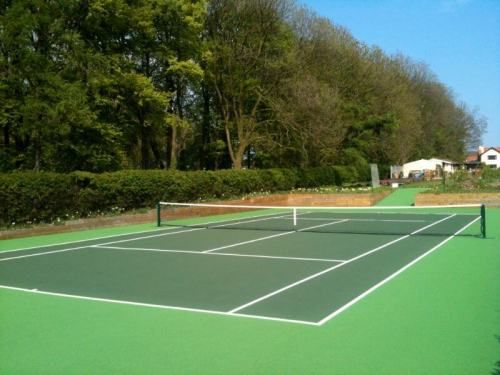The Process of Tennis Court Resurfacing
September 8, 2022

The process of tennis court resurfacing begins with deep repairs. A team of professionals removes debris from the cracks and removes the previous material used to fill the cracks. This outdated material is removed by means of a diamond saw or pressure washer. The resurfacing team then sands the area smooth. Then, they apply a new coating that fills the voids and adds a cushioned finish.
A simple repair can be completed in as little as three days. Comprehensive resurfacing will require painting of the entire court. A multi-layer paint system is applied to the court to seal cracks and protect the surface from damage and increase its aesthetics. The process is typically completed in a single day. The cost of a resurfaced tennis court depends on the extent of damage.
During the resurfacing process, your court must be cleaned properly and thoroughly. You can use a power washer or degreaser to clean the surface. Once the surface is clean, you can apply a mild detergent to the surface to prevent mold and mildew from growing. The process will create a beautiful and safe surface that is ready for use in a few weeks. You’ll need to keep the area clean and free of dirt and debris. You should also avoid using skateboards on a tennis court.
Resurfacing a tennis court starts with a comprehensive repair process. The quality of the repairs is essential for a successful resurfacing. Structural cracks are repaired with a concrete compound, and low spots and depressions are fixed with cement skim coats. The surface leveling process is done to ensure that water does not accumulate in these areas and break the acrylic coating system. A full resurfacing process will include perimeter correction, the removal of old delaminated court material, and high spot removal.
The process of resurfacing a tennis court is usually done in two to three days. The total time required for a resurfacing depends on the damage to the surface. However, proper installation and drainage will prevent any water from flooding the surface, preventing mould and mildew from growing. The resurfacing process will ensure that your tennis court stays clean and safe for a longer period of time. This is one of the most effective ways to increase the life of a tennis court.
Resurfacing a tennis court is necessary if it has developed cracks, which can cause the surface to shift and cause injuries. In addition, the surface must be cleaned properly to avoid the formation of cracked areas. During the repair process, it is necessary to remove existing organic matter such as leaves and grass. After cleaning the court, it is important to remove all debris and trim the vegetation. Ideally, the surface is level and there should be no visible signs of weeds or roots that have grown over it.
If you are ready to restore or tennis court resurfacing its former glory, call the friendly experts at Champion Grass today.
